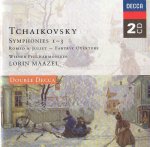An earlier Double-Decca reissue included Vladimir Ashkenazy’s Philharmonia recordings of the last three Tchaikovsky symphonies. Now, for the earlier symphonies and Romeo and Juliet, Decca exhumes recordings made in the mid-1960s (Symphonies Nos. 2 and 3 have circulated more recently on the Belafon label) made by Lorin Maazel and the Vienna Philharmonic at the Vienna Sofiensaal. And what drive and energy the young Maazel brought to this music! The finales of Symphonies Nos. 2 (“Little Russian”) and 3 (“Polish”) attest most powerfully to the fact, but these readings also tend toward crudeness.
Maazel’s account of the Symphony No. 1 (“Winter Daydreams”) is nicely calculated, though, with a feeling of chilly spaciousness to the first movement that’s instantly suggestive of Mariss Jansons’ outstanding Chandos performance with the Oslo Philharmonic. The slow movement brings moments of poignancy, capturing the dark-hued atmosphere of Tchaikovsky’s “Land of Gloom and Mists”, and Maazel also is adept at shaping the themes of the folksy Scherzo. Only the finale seriously disappoints–the coda degenerates into a noisy display that might have been more tolerable had the bronchial-sounding Vienna trombones managed to play better in tune.
Symphony No. 2 gets a straightforward, unsophisticated reading that’s equally high on adrenalin. (The recording features a truly earth-shattering tam-tam stroke, for instance, just before the racy coda begins.) But for both works there are many superior alternatives: Jansons is excellent, and the Delos coupling from Gerard Schwarz and the Seattle Symphony offers highly convincing and polished interpretations in demonstration quality sound. Symphony No. 3 always is a problematic work. Its five movements form an unstable organic unity at the best of times, and the chief weakness of this account is Maazel’s failure to characterize the work adequately. The central slow movement is nicely done, as is the second of the two scherzos, but Maazel’s finale is rather coarse and unpolished, though undeniably–and unsubtly–exciting.
One of the best recent Tchaikovsky Thirds comes from Leonard Slatkin and the St. Louis Symphony on RCA; it’s one of few accounts of the work that manages to make the structure hang together convincingly. Finally, Leonard Bernstein’s 1970 New York Philharmonic Sony reissue of the symphony, a performance that’s a good deal more sure-footed and plausible than Maazel’s, also includes Lenny’s most charismatic Romeo & Juliet. But on the plus side, Decca’s mid-1960s sound for Maazel is more than acceptable, and collectors unconcerned by the theatrics should find his performances enjoyable enough.
































